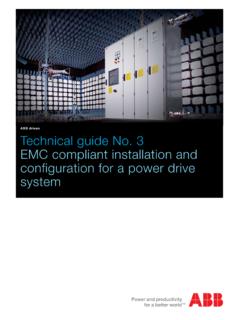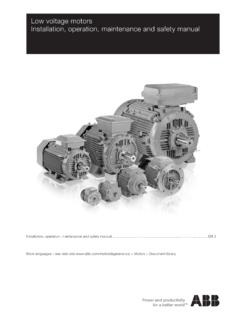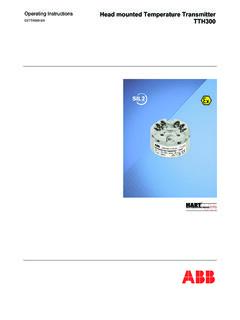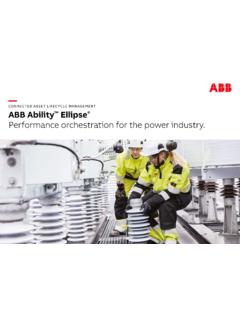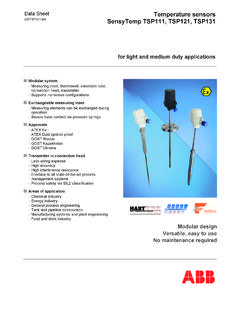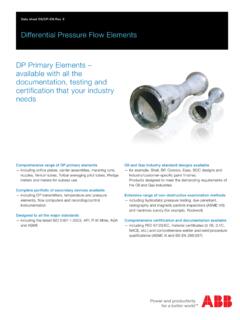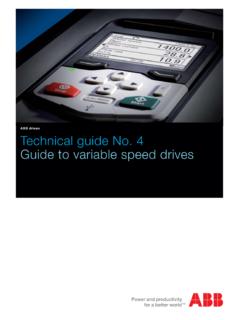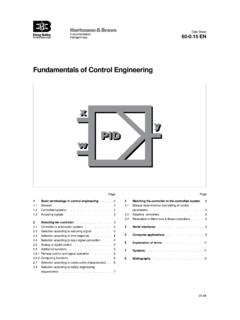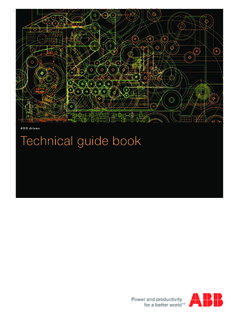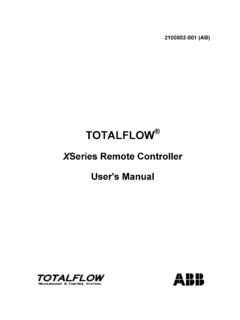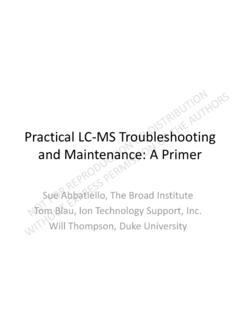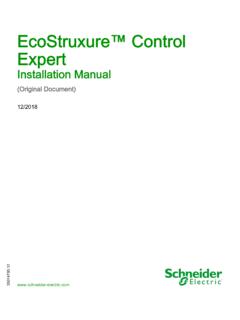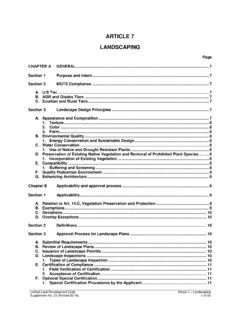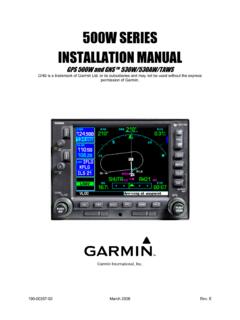Transcription of Manual Guidelines for Contactor inspection and …
1 Manual Guidelines for Contactor inspection and maintenance ABB A/AF-line and EH/EK series contactors The purpose of this Manual is to provide guidance for correct selection and maintenance of contactors in in- dustrial installations to ensure a trouble free operation. This without increasing the overall cost. 2 ABB Contactor Manual | 1 SFC101044M0201, rev B. Contents Some general Mechanical maintenance of Interpreting levels of electrical contact wear Changing main contacts, arc chutes and Trouble Spare parts and warranty Contactor parts 1 SFC101044M0201, rev B | ABB Contactor Manual 3. Some general advice 1. Choose correctly 3. Storage and climate Nature of the duty Consider the immediate environment Positioning of the Contactor (variable temperatures, humidity, storage Voltage and frequency conditions etc).
2 Frequency of operation Safety regulations 4. Connections Electrical and mechanical stresses Make sure the recommended torque val- ues given in the instructions are followed 2. Mounting/ installation and that proper torque checks depending The instructions supplied with every on the application are done. Contactor should be followed. In case of drilling in the panel make sure to protect the Contactor from falling metal shavings that otherwise could lead to excessive hum or flashovers. 4 ABB Contactor Manual | 1 SFC101044M0201, rev B. Mechanical wear The number of mechanical operations For more specific information regarding has a low impact on the life of the main this please see our technical catalog contacts and their overall electrical life.
3 1 SBC1001122C0202, section: General However general information concer- Technical Data. ning mechanical wear could be of interest. Contact bounce The operational limit of the Contactor is AC-Hum between 85 and 110% of the rated coil Pollution of the magnet pole surfaces voltage according to IEC60947-4-1. A. will create a slight hum coming from the voltage variation of 5% of the above Contactor in the closed position. When limits will increase the contact bounce that cleaning, use a soft and dry piece of cloth. leads to increased contact wear (does not Hum can also occur if the pole surfaces apply to AF with its electronic wide range are deformed. A louder hum will occur if coil). The reason for this is that higher the shading coil (does not apply to AF) is voltages will increase the speed of the broken because the magnet will cause the electromagnet at closing.
4 Lower voltages Contactor to chatter. If so the complete will decrease the speed at closing. Both Contactor needs to be exchanged. Another these factors can lead to a higher level of reason for AC-hum could be corrosion contact bounce at closing. High voltage caused by environmental conditions that and the increased speed at closing also exceed the Contactor specifications. Con- contribute to some increased sound. tactors need to be protected from conden- sation in order to keep the pole surfaces of the magnet free from corrosion. 1 SFC101044M0201, rev B | ABB Contactor Manual 5. maintenance of contacts A contact is not necessarily damaged or worn out, just because the surface is rough and discolored. The contacts in the figure below may look like bad contacts but the fact is that they are better than a new set of contacts.
5 This is because they are electrically sea- ted and make good contact over a larger surface. Based on this it would be completely wrong to change a contact only by judging from the appearance of the surface. Also it is quite normal that the contacts in the three phases are not evenly worn and because of this all contacts both fixed and movable need to be changed. At the same time it is recommended to change the arc chutes. inspection of contacts With today s high performance contactors , filing, grinding, or other attempts to restore contacts or contact surfaces should be avoided. Our experience shows that filing and grinding increases the risk of causing other problems. For example the risk of increasing the contacts resistance is high due to scrap from this grinding and filing.
6 maintenance should be limited to inspection of the contacts for the level of contact wear. This is to ensure a trouble free operation of the Contactor until the next service is requi- red (see next section Interpreting levels of electrical contact wear). At the same time observations can be made to judge if the Contactor operates well in the application and that no signs of abnormal wear or damages are present on the contacts. 1. The appearance of contacts after a very low number of operation in an AC-3 application 2. A contact just having reached a good worn in' level in an AC-3 application 1 2. 6 ABB Contactor Manual | 1 SFC101044M0201, rev B. Interpreting levels of electrical contact wear General Depending on the severity of the application contact inspection may be required.
7 A. typical severe application would involve frequent making and breaking of high currents, reversing and inching (AC4). Premature service on contactors will increase the overall cost while delayed service could cause costly interruptions or breakdowns. Service at the right time will avoid these kind of problems. The following main utilization categories are the most common ones. AC-1. (General purpose) Non-inductive or slightly inductive loads, resistance furnaces. The closing of the main contacts is relatively easy as the initial current is equivalent to the rated current of the load. Breaking is made at full voltage, the arc has a rather low level of energy. AC-2. Slip-ring motors. Starting, switching off. Typical making and breaking is with approximately 2,5 times the rated current of the motor (Ie x ) the voltage is corresponding to the nominal voltage.
8 1 SFC101044M0201, rev B | ABB Contactor Manual 7. AC-3. Cage motors. Starting, switching off running motors. Closing of the main contacts with approximately 6 to 8 times (or higher with today s high efficiency motors) the rated motor current, depending on motor characteristics and type of load. Breaking is easier, as the current equals the rated motor current, and voltage is reduced to 17 % of the rated voltage. Typical electrical wear comes from the contact making operation. Visual inspection of an AC-3 application normally shows none or very little material from the contact tips thrown out into the arc chutes. 1. Early stage of fixed and movable contacts in an AC-3 application 2. Mid-life stage of fixed and movable contacts in an AC-3 application 3.
9 End of life of fixed and movable contacts in an AC-3 application 1. 2 3. 8 ABB Contactor Manual | 1 SFC101044M0201, rev B. AC 4. Cage motors. Starting, plugging, inching. Making and breaking the motor starting current approximately 6 to 8 times (or higher with today s high efficiency motors) the rated motor current. Voltage is not reduced and equals the rated voltage of the motor. Both making and breaking are contributing to the contact wear. The arc chutes have an important role in extinguishing the arc. Therefore material from the contact tips is in most cases thrown out in the packages. See picture B below. 1. Early stage of fixed and movable contacts, 5000 operations 2. Mid-life stage of fixed (above) and movable contacts (right) 10000 operations 3.
10 End of life in AC-4 application A. Typical appearance of contacts B. Typical appearance of an arc chute 1. 2. 3 A B. 1 SFC101044M0201, rev B | ABB Contactor Manual 9. Changing main contacts, arc chutes and coils For information on how to take the When changing the AF coil with its PCB. contactors apart see the instruction (printed circuit board) care must be that comes with the contactors or go to taken to avoid ESD damage. if instruction is not available. Before any dismantling of the Contactor : Make dead by, turning off the Contactor . Opening the main circuit by turning off the main switch, if any, or by removing the main fuses in all three phases. To protect against making attempt, open also the con- trol circuit.
